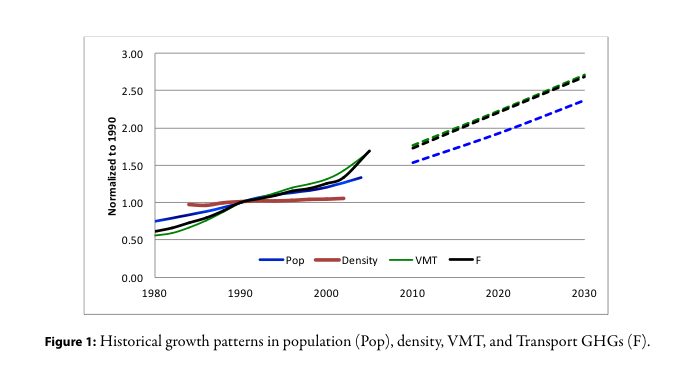THE JOURNAL OF TRANSPORT AND LAND USE
Abstract
In light of the increasing reliance on compact growth as a fundamental strategy for reducing vehicle emissions, it is important to better understand how land use-transportation interactions influence the production of mobile source emissions. To date, research findings have produced mixed conclusions as to whether compact development as a strategy for accommodating urban growth significantly reduces vehicle travel and, by extension, mitigates environmental impacts, particularly in the area of air quality. Using an integrated simulation approach coupled with long-term land development scenarios, we conducted an assessment of the impacts of different long-term primarily residential growth patterns on vehicle travel and pollutant emissions in the eight counties of the San Joaquin Valley region in central California. The results suggest that higher residential densities result in slightly decreased regional vehicle travel and emissions. Our comparative analysis also suggests that the effects of future land use growth patterns may vary among different spatial areas. That is, compact growth strategies can result in significantly more travel and emissions changes in already fairly urbanized counties. This work indicates a minimum density threshold of approximately 1500 households per square mile is necessary to achieve commensurate emissions reductions relative to existing densities.
Introduction
Linking land use, transportation, and air quality has become an increasingly critical need in contemporary urban planning. In particular, a better understanding of the effects on travel activity and vehicle emissions of land use strategies and growth management policies that prioritize compact development is critical for facilitating effective long-term planning decisions. However, the land use-transportation interaction is complicated. To date, research has produced mixed conclusions as to whether compact development as a strategy for accommodating urban growth significantly reduces vehicle travel (e.g. Badoe and Miller 2000) and, by extension, mitigates environ- mental impacts, particularly in the area of air quality. For ex- ample, some studies have found that higher residential densities are typically associated with lower regional per capita travel (Ewing and Cervero 2001; Ewing et al. 2002; Golob and Brownstone 2005), shorter trip length (Cervero 1996), lower vehicle trip rates (Cervero and Kockelman 1997; Ewing and Cervero 2001), and higher non-auto mode splits (Dunphy and Fisher 1996; Ewing et al. 2002). Other studies have suggested that the relationship between density and travel activity is unclear, or that there are no direct effects (e.g. Kockelman 1997; Miller and Ibrahim 1998; Pickrell 1999).
The Journal of Transport and Land Use
www.jtlu.org
“The Journal of Transport and Land Use publishes original interdisciplinary papers on the interaction of transport and land use. Domains include: engineering, planning, modeling, behavior, economics, geography, regional science, sociology, architecture and design, network science, and complex systems. Papers reporting innovative methodologies, original data, and new empirical findings are especially encouraged.”







 RSS Feed
RSS Feed